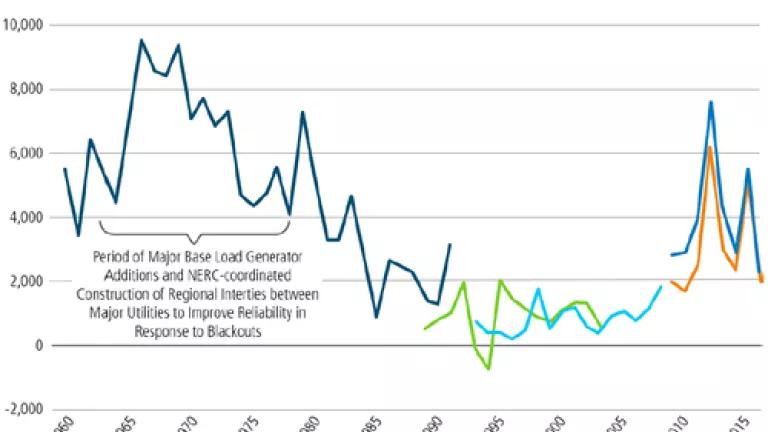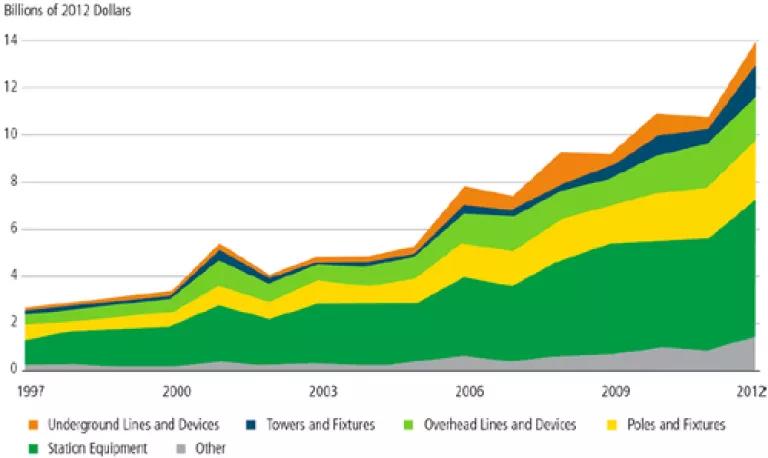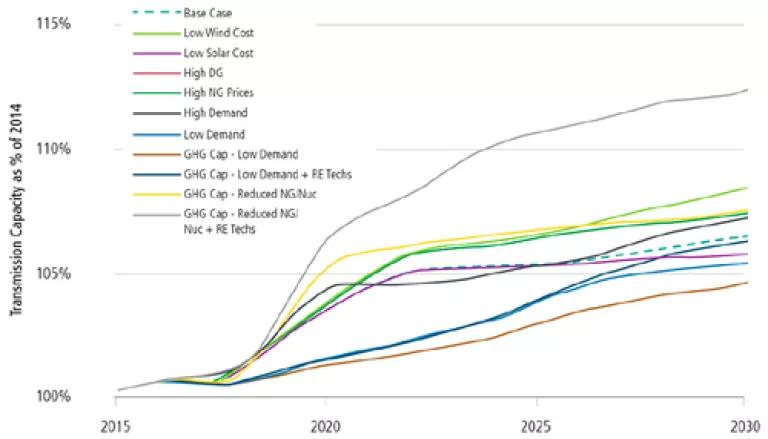New Transmission Lines Needed to Achieve Clean Power Goals May Be Less Than Required for Business as Usual

Recently released details of a Department of Energy (DOE) study confirm that the amount of new transmission lines we need in order to achieve - or even surpass - our nationwide carbon pollution reduction goals by 2030 is comparable to the transmission we would build anyway.
Even more notably, some of the scenarios DOE studied show we can meet our carbon reduction goals and build even less transmission infrastructure (wires and poles) than required by business as usual. This is good news because transmission costs - and savings - are typically passed along to electricity consumers.
Lowering electricity demand cuts transmission needs and costs
Transmission buildout can be reduced by lowering electricity consumption when electricity use is at its highest - and this can be achieved without requiring consumers to forgo electricity when they really need it.
· Energy efficiency programs allow for smarter use of energy - and existing transmission infrastructure. Part of what drives expansion of the transmission system, like the highway system, is "rush hour" traffic. Just as we build roads wide enough to accommodate rush hour commuters, we build the electricity transmission system to accommodate all users during transmission grid "rush hour" - or the highest periods of use. There is congestion during rush hour, but the cheapest solution is not expanding the road or the transmission lines. It's better to encourage carpooling when it comes to our roads and similarly, energy efficiency programs that make homes and business run on less energy, such as weatherization efforts or rebates for high efficiency appliances and equipment. Reduced electricity demand also lessens the need to generate it by burning fossils like coal, which creates pollution that harms our health and fuels climate change.
· Demand response programs also have a highway analogy: truck drivers, by taking advantage of the open roads at night, are not adding to rush hour traffic, and that saves us from having to widen the highways to accommodate them at rush hour. On the transmission grid, demand response programs encourage electricity consumers who are flexible to avoid rush hour on the grid and use electricity at other times (e.g., by running dishwashers at night). This shift in use also alleviates congestion and saves us from needlessly spending to expand transmission.
DOE's study
To study our nation's future transmission needs, the DOE compared a business as usual case to 23 scenarios probing how electric generation and consumption could change and thus drive the need for additional transmission. The scenarios considered a carbon dioxide emissions cap to achieve a 40 percent economy-wide reduction in 2030 - which goes beyond the federal Clean Power Plan to limit pollution from power plants - as well as a range of renewable technology costs, natural gas prices, nuclear plant retirements, and electricity demand.
What is business as usual? In setting up the business as usual case for DOE's study, it's important to note that our transmission infrastructure is old and needs an upgrade. Our transmission lines were largely built in the 1960s, and new line construction has just recently started to pick up again.

Source - DOE: Spending on transmission infrastructure (not just spending to add lines to the grid). The period here represents a time when transmission lines added was at minimum.
Thus, as part of business as usual, we are already spending billions of dollars updating our transmission system, and transmission buildout is expected to continue increasing.
What are DOE's results? Nearly all scenarios studied produce transmission needs through 2030 similar to that for the business as usual case. Further, as emphasized earlier, there are scenarios involving low demand and/or high amounts of local generation (such as rooftop solar power) that satisfy our carbon dioxide reduction goals and require even less transmission than business as usual. These results are largely consistent with other studies. In particular, modeling in the West projected that investments that lower electricity demand (such as energy efficiency, demand response, and rooftop solar power) could save $10 billion in transmission capital costs, which is 36 percent below the business as usual case.

Source - DOE: Most of the scenarios are within a few percentage points of the business as usual case (dotted line). Included are 10 scenarios representing the spread in transmission needs from DOE's study. The top curve is the extreme transmission case (explained below).
Wait ... what is that top curve? For one of the 23 scenarios, DOE simulated circumstances driving an extremely high amount of transmission building. The scenario was not meant to be predictive or correspond to any government program but was intended to strain the transmission system. It examined the combined impact of accelerated nuclear plant retirements, a 60 percent carbon dioxide reduction from the electricity sector by 2030, high natural gas prices, and low costs for renewable energy technologies. Together, these assumptions would alter our energy mix to be about one-third from emissions-free wind and solar power by 2030.
While this scenario required more transmission than the other scenarios in the study (because the scenario's inputs increase the likelihood that the new power is not generated where the existing transmission lines are sited), the rate of transmission investment needed even for this extreme case was within the range of historical and planned near-future builds.

Source - DOE. Nearly all scenarios produced transmission needs similar to that for the business as usual case (dark blue bar), which is modest relative to recent builds (light gray bar). Even the extreme transmission case (light blue bar) and some of the other "high transmission" cases are comparable to the historical build.
What do all these wonky details mean?
Our clean grid future will likely require comparable or less transmission investment than business as usual, which shows a clean energy future is possible without adding unexpected costs to consumers' utility bills. That's also good news for our health and environment.
